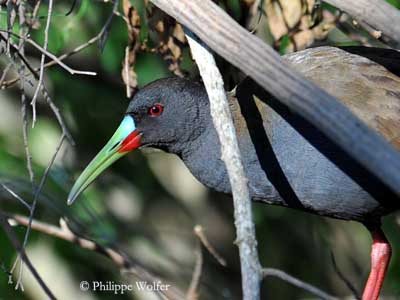
RALLIDAE FAMILY
Coots, Moorhens, Crakes, Rails and Swamphens
The Rallidae, Order Gruiformes, are terrestrial, marsh and aquatic birds. They frequent watersides of freshwater marshes and lakes.
These birds are often seen walking on exposed muddy areas, or clambering among the emergent vegetation. However, coots and moorhens usually spend most of the day swimming in open water.
Rallidae have short, broad, rounded wings, but they often are flightless. Theses birds prefer to run to escape predators, rather than to take off. But several species are migratory and able to fly.
Text by Nicole Bouglouan
Photographers:
Audevard Aurélienn
OUESSANT DIGISCOPING
Bouglouan Nicole
PHOTOGRAPHIC RAMBLE
Buysse Didier
Vision d’Oiseaux
Colón Archilla Alfredo D.
Puerto Rico Wildlife
Chrétien Marc
MURINUS
Dechelle Maxime
LEPAPARRAZO
Grey Tom
Tom Grey's Bird Pictures
Guillet Paul
Photos d'Oiseaux
Ken Havard
My Bird Gallery & Flickr gallery 1 & Flickr gallery 2
Patrick Ingremeau
TAMANDUA
Lortie René
http://rlortie.ca/
Merigan Tom
Tom Merigan’s Photo Galleries
Mistry Niraj Vijaykumar
Photo Galleries
Moul Bob
Nature Photography
Peers Jean Michel
JMPN PHOTOGRAPHIE
Jean Marc Rabby
Des Ailes et des Plumes
Callie de Wet
GALLERY
Philippe Wolfer
OISEAUX D’ARGENTINE
Sources :
HANDBOOK OF THE BIRDS OF THE WORLD Volume 3 by Josep del Hoyo-Andrew Elliott-Jordi Sargatal - Lynx Edicions - ISBN : 8487334202
THE HANDBOOK OF BIRD IDENTIFICATION FOR EUROPE AND THE WESTERN PALEARCTIC by Mark Beaman, Steve Madge - C.Helm - ISBN: 0713639601
L’ENCYCLOPEDIE MONDIALE DES OISEAUX - Dr Christopher M. Perrins - BORDAS - ISBN: 2040185607
Wikipedia (Wikipedia, The Free Encyclopedia)
Summary articles

The bill is variable in structure. We can find long-billed rails which probe in soft ground and leaf litter. Others have small, fine bills, and take mainly insects and seeds. The Rallidae with large, stout bills graze on land, and dig out roots and tubers from the ground, or tear off vegetation.
The bill is often brightly coloured, contrasting with the dull colours of the plumage.

Rallidae have well developed and often strong legs. The toes are long and slender in all aquatic and marsh birds, but the terrestrial species have shorter and heavier feet.
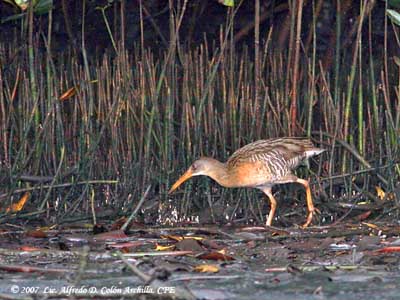
These birds move through the vegetation where their slender body allows them to walk into the dense cover. They even may run if threatened, compressing the body to move betweens the stems. They can swim, dive or sink into water, using the wings for propel them under water.
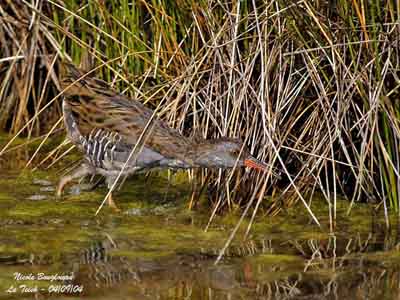
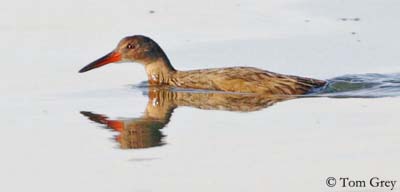
The plumage is often cryptic, with brown, chestnut, black and grey. But the genus “Porphyrio” shows iridescent purple, blue or green plumage.
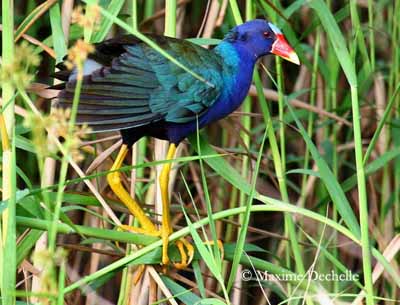
Other genuses such as “Rallus”, “Gallirallus” and “Porzana” often have barred flanks, whereas pale vent and undertail coverts contrast with the duller body plumage.
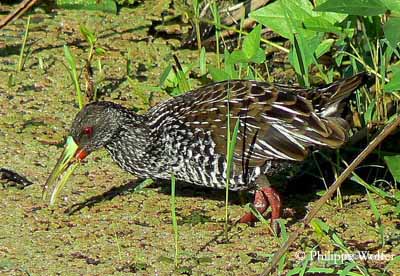
In most species, both sexes are similar or almost alike. Only few species have marked sexual dimorphism.
The chicks are typically covered in black or dark brown down.
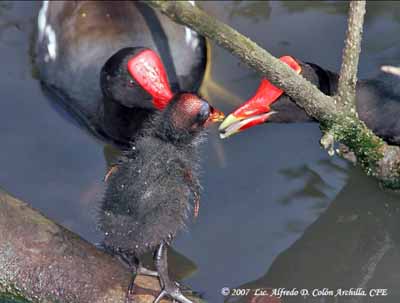
Rallidae perform laboured and fluttering flight action, often with dangling legs when flushed. We can think they have a poor flying ability. However, these birds are able to fly strongly and steadily when well under way, with the feet projected beyond the short tail. And most of the species are highly migratory.
They have varied movements and dispersal patterns, with long distance migrant species and numerous others dispersive or nomadic. We can observe local movements, according to the changes in the habitat and the food resources.
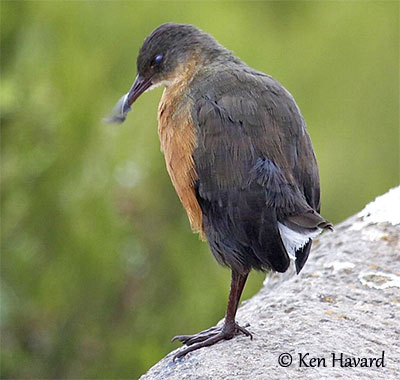
The migrations of Rallidae are poorly known, because these birds often move at night and at low height, singly or in small groups. The rails are attracted by the lights, and may strike buildings and towers, fences and wires while migrating.
Even the flightless species may move for significant distances, such as the Weka in New Zealand, which can travel more than 4 km per day for immature birds. The greatest movement is of 35 km by an adult male!

Also in New Zealand, the Takahe (Porphyrio hochstetteri) performs altitudinal movements of up to 5-10 km and more, when the snow covers its grassy feeding areas.
Several species, adult sand young, may move for some kilometres if necessary.
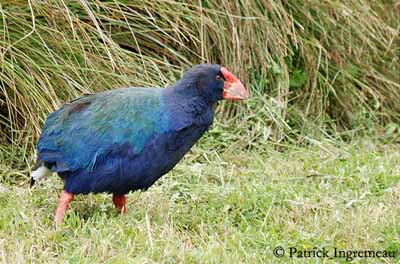
Rallidae frequent several types of freshwater wetlands such as swamps, marshes, floodplains, ponds, ditches, ricefields, streamsides, dams and lakes. The genus “Porphyrio” prefers floating vegetation, but this type of habitat is often disappearing, involving threatened species.
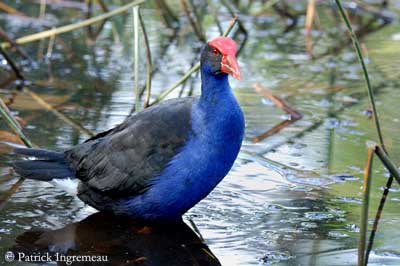
Coots are the most aquatic and usually frequent water bodies such as freshwater lakes and ponds, or brackish water areas, bays and arms of sea.
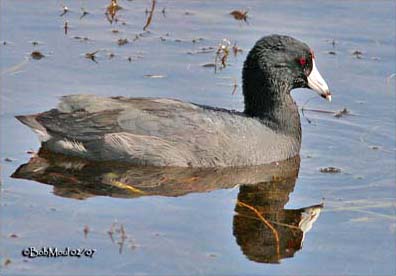
Several Rallidae species live in various types of warm forests, from lowland to highland areas, but never far from water. Others are associated with grassland habitats, and have to move according to the weather or the season, and the fires during the dry season, especially in Africa. For these reasons, the African Crake (Crex egregia) and the Streaky-breasted Flufftail (Sarothrura boehmi) occupy their areas only seasonally.
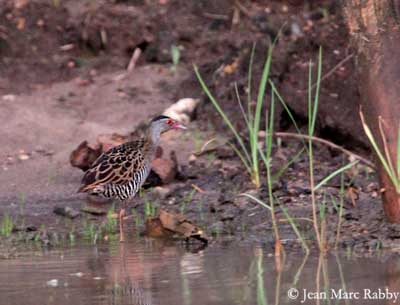
Rallidae are omnivorous, often opportunistic, and able to adapt to new habitats or food sources.
Some species are mainly vegetarian and other dependent on invertebrates. But many species feed on the most abundant vegetal or animal foods available all year round.
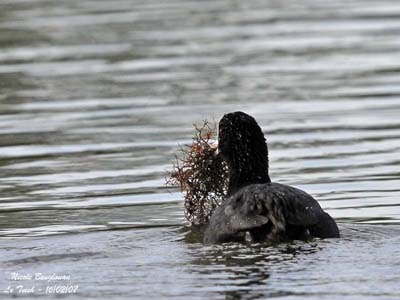
They feed on seeds, shoots, stems and leaves, tubers, roots, marine algae, fungi and lichens. They may take cultivated plants such as rice and maize, fruits such as apples, melons, tomatoes, apricots and bananas.
But invertebrates are important part of the diet of numerous Rallidae species, including worms, leeches, molluscs, millipedes, crabs and crayfish, some spiders and insects and their larvae.
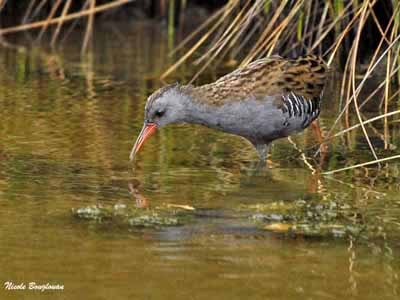
Some species feed on small fish, amphibians and tadpoles, lizards, small snakes, eggs and young of other birds, rodents (mice or rats), carrion and several varied food items such as bread, dog and chicken food, butter, biscuits…
The aquatic species, coots and gallinules, are mainly vegetarian. The inhabitants of terrestrial and palustrine areas may be seasonally carnivorous or omnivorous. On the other hand, the forest species take very little plant matter.
The behaviour of these birds is poorly studied, but usually, Rallidae are solitary or in pairs, in family groups or in small flocks. The coots are more gregarious and may be seen in great numbers in the same water area. Except the Giant Coot, species such as Common, American, Red-knobbed, White-winged and Andean Coots forage in large monospecific flocks outside the breeding season.
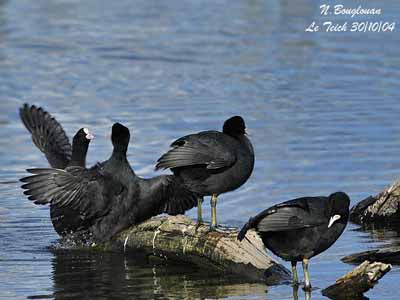
Some gallinules may forage in loose flocks in non-breeding period.
Common and Dusky Moorhens and Purple Swamphens may live in social groups outside the breeding season, but there is a social hierarchy with males dominant to females, and adults dominant to immatures.
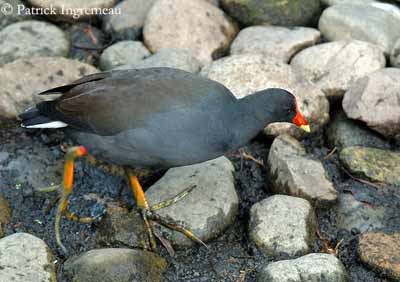
Other species such as Black Crakes, Lesser Moorhens and Allen’s Gallinules may occur and breed in high densities in the emergent vegetation of irregular flooded river systems in the Afrotropics.
Some sedentary species defend their permanent territories and remain in pair all year round.
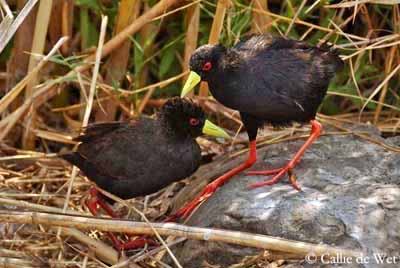
They are mainly diurnal, but several species are active by night too. The Plumbeous Rail gives advertising calls by night and may be active in marshes or ricefields during the night. The Weka and the Grey-necked Wood Rails forage at night as well as by day.
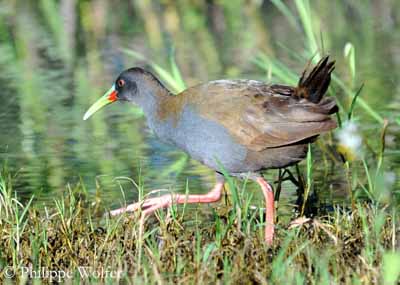
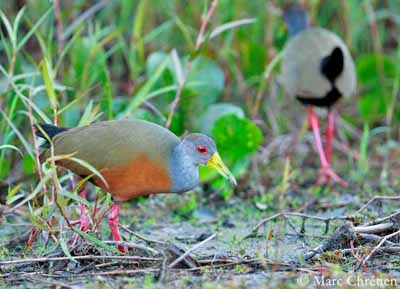
Common Moorhens and Common Coots are sometimes active on moonlight nights on their open habitats.
Rails roost solitary or in pairs or family groups, except for the flocking species. They roost usually in dense cover on the ground, or in thick vegetation. The forested species and some flightless birds may roost in trees to avoid predation.
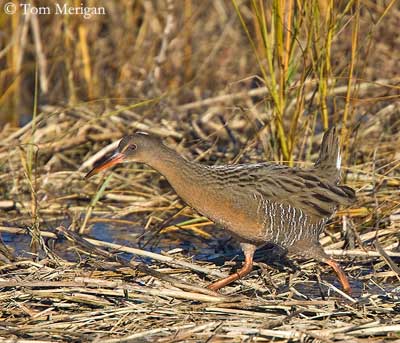
The calls of Rallidae may vary from sweet to harsh, including screams, squeals, whistles, rattles, grunts and barks.
They give repetitive advertising calls in territorial defence, mainly in the early morning and the evening.
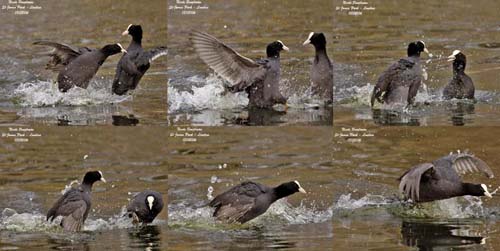
They also produce non-vocal sounds such as wing-clapping. The Purple Swamphen uses wing-clapping to distract the predators. Coots, moorhens and many rails beat the water with the wings in aggressive displays, and slapping noises are made with the feet.
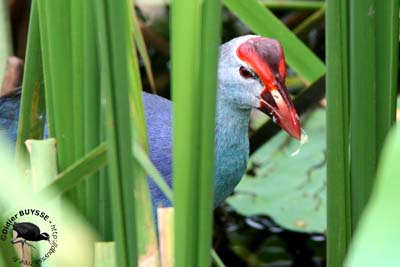
Most rails are very vocal, but these birds need this type of communication while living in dense vegetation where visual contact is almost impossible.
They have an extensive vocal repertoire, used in defence and courtship displays, contact calls, alarm and distress calls. Advertising calls are often far-carrying, such as the whistle call of the Spotted Crake, audible for about 2 km.
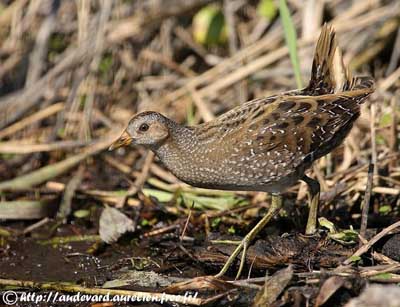
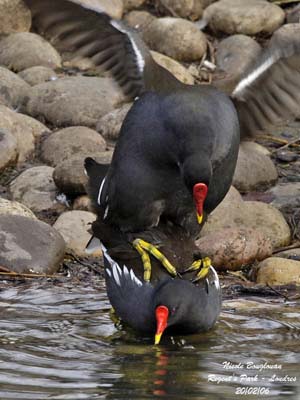
Rallidae breed seasonally, during spring and summer in temperate regions, and in or near the wet season in the tropics. These facts are not true for all the species, but most of them follow this pattern.
Rails initiate the breeding activities by increasing calling. Sexual displays seem to have limited repertoire in this family. Courtship displays are simple, and in some species, copulation occurs without preceding displays.
But in some other species, the male bows with head down and tail up and sometimes raised wings, as in the Water Rail.
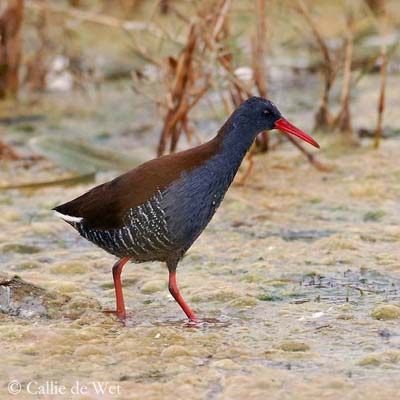
The male Virginia Rail runs around the female with raised wings, stretched neck and high-stepping gait. Male of the genus “Sarothrura” vibrate the tail rapidly from side to side with bowing or upright stance.

Courtship displays also expose the barred flank pattern of some species, and the contrasting undertail coverts. These displays are accompanied by calls.
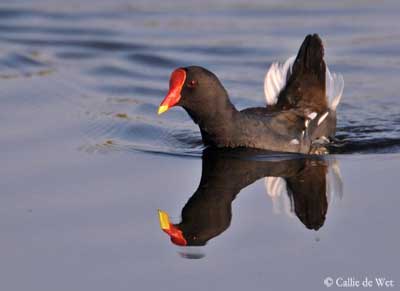
Most species nest solitary and well separated, except when the nesting habitat is scarce. In this type of restricted nesting habitat, the Purple Swamphens may nest in loose colonies.
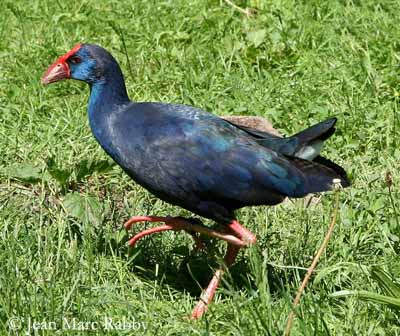
The nest, often chosen by the male but sometimes by both mates, is usually hidden among the dense vegetation. It is situated in the emergent vegetation, in reeds or grass. The surrounding and overhanging vegetation is pulled down or woven as a “roof” for better concealment.
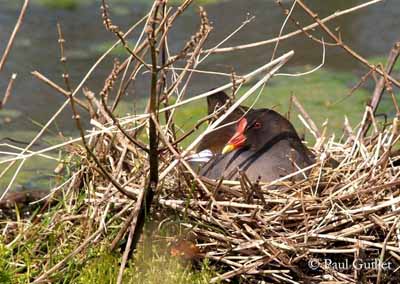
The nests situated in wetlands have pathways or ramp up to the cup.
Some rails build the nest on floating vegetation, and attach it to the aquatic plants.
Gallinules and moorhens often build the nest at water level or on water, and are often destroyed with flooding.
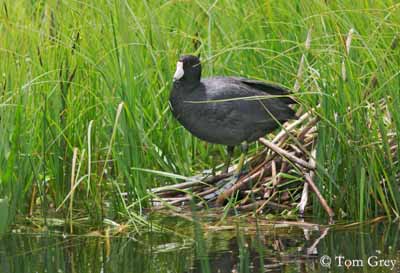
The Giant Coot builds an enormous nest of aquatic vegetation about 50 cm above water. The Horned Coot builds also a huge nest with water weed, placed on conical mound of stones, of about four metres in diameter at base, and about 60 cm high, with a platform just below the water.
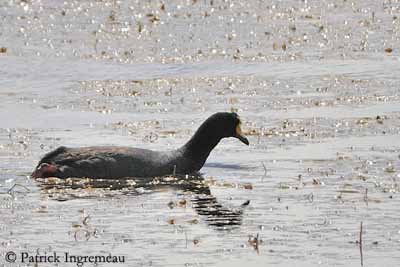
Females lay between 1 to 19 eggs, usually 5-10, but laying by more than one female occurs. Colours of the eggs may vary according to the species. Incubation lasts about 15-19 days.

Nest with eggs
The exception is the Chestnut Forest Rail which lay only one large egg incubated during at least 34 days, the longest in this family.
Incubation is often by both sexes.
Chicks are precocial or semi-precocial and leave the nest within 1-3 days after hatching. They are brooded by night at nest by their parents. They are able to dive and swim is necessary.

They are fed bill to bill by parents, but they become independent from a few days to over eight weeks.
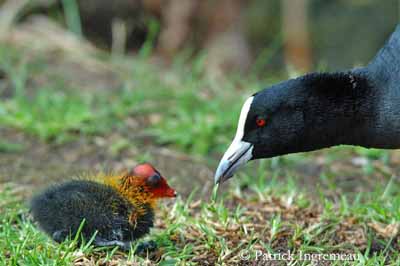
Some species such as the Virginia Rail and the Buff-banded Rail may carry the eggs in the bill in order to move the clutch if the nest is disturbed.

The young birds fledge between four and eight weeks, but in the Giant Coot, this period lasts about four months.
Rallidae usually produce one or two broods per season, and replacement laying may occur is the eggs are lost.
Rallidae are found on all continents and numerous islands, except Antarctica.
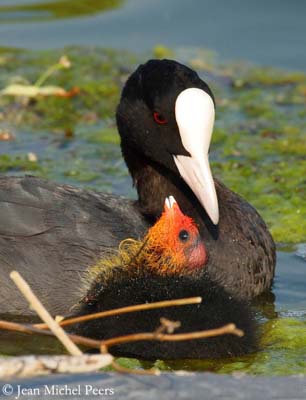
They are vulnerable to the introduced animal’s species which destroy the eggs and nestlings on the ground, and especially on islands, and the colonisation of these islands involved the extinction of several species. Drainage of wetlands, changes in the habitat, flooding, destruction of mangroves and lagoon habitats for housing development, disturbances by humans… there is a lot of threats and few solutions at this moment.
Serious efforts are required to prevent the increase of the list of extinct species.